The state of Louisiana is home to a wide variety of birds, from the majestic bald eagle that soars over its wetlands to the brightly colored warbler that flits through the trees.
With over 400 species of birds, Louisiana is a birdwatcher’s paradise. From the swamps of the Atchafalaya Basin to the rolling hills of northern Louisiana, birds of all shapes and sizes can be seen.
Louisiana’s birds come in an array of brilliant colors, making them a beautiful addition to any landscape. From the state bird, the brown pelican, to the yellow-breasted chat and the great blue heron, Louisiana has an abundance of avian life.
Whether you are a seasoned birdwatcher or just starting out, Louisiana is a great place to explore the beauty of birds.
1. Northern Cardinal

The Northern Cardinal is a beautiful bird, easily identified by its bright red plumage. It can be found in the eastern United States from Maine to Minnesota and south through Mexico and Belize.
Along with its striking colouration, it has a distinctive crest on its head and sharp black facial markings around the eyes.
Despite their small size (measuring 7-9 inches) they are very vocal birds – males sing persistently throughout springtime to attract mates or proclaim their territory.
They typically feed on insects, seeds and fruits but also enjoy suet at backyard bird feeders.
The female is less brightly coloured than her mate but still stands out among other songbirds due to her warm brownish-red feathers.
Cardinals pair for life so you may often see them together in your garden or neighbourhood park.Scientific classification:
| Kingdom | Animalia |
| Phylum | Chordata |
| Class | Aves |
| Order | Passeriformes |
| Family | Cardinalidae |
| Genus | Cardinalis |
| Species | C. cardinalis |
2. Pelican
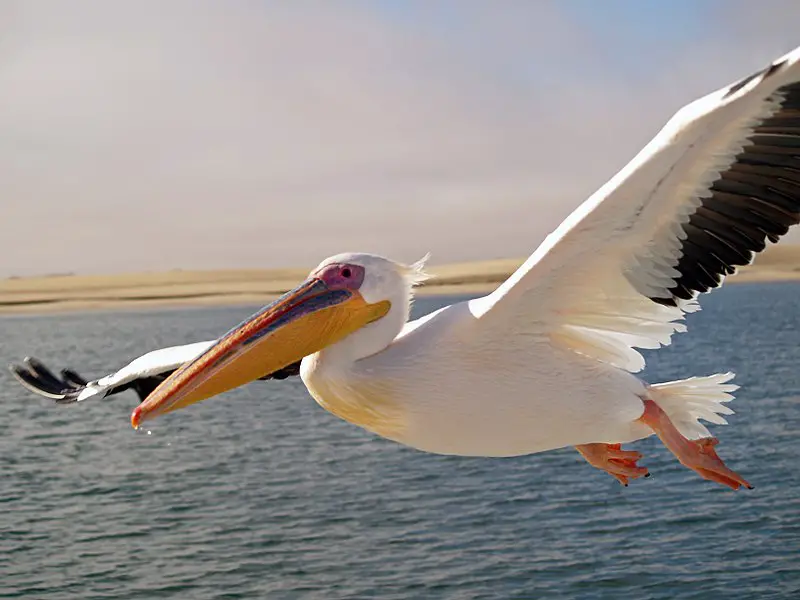
Pelicans are a large water bird and form part of the family Pelecanidae. They have long beaks, allowing them to scoop up prey from both land and sea with ease.
Their most distinctive feature is their huge throat pouch which they use to drain water before swallowing their food.
Most pelican species have predominantly pale plumage however exceptions such as the brown and Peruvian pelicans exhibit darker colouring.
The bill, face skin and pouch of all Pelican species become brightly coloured during breeding season in order to attract mates.
Pelicans can often live up to 25 years due to the fact that they eat mostly fish which provides them with enough nutrients for longevity.Scientific classification:
| Kingdom | Animalia |
| Phylum | Chordata |
| Class | Aves |
| Order | Pelecaniformes |
| Family | Pelecanidae |
| Genus | Pelecanus Linnaeus, 1758 |
3. American Robin

The American robin is a migratory bird, belonging to the true thrush genus and Turdidae family.
It was named after its European counterpart due to the similar reddish-orange breast they both possess; however, they are not related closely.
This species can be seen through most of North America during winter months, as well as in parts of Mexico and Central America where it also breeds.
They have plump bodies with gray upperparts and white underparts that vary from yellow on their throats down to orange toward their bellies.
Robins feed on fruits such as berries or insects like worms which makes them an important part of ecosystems by helping disperse seeds naturally throughout these areas.Scientific classification:
| Kingdom | Animalia |
| Phylum | Chordata |
| Class | Aves |
| Order | Passeriformes |
| Family | Turdidae |
| Genus | Turdus |
| Species | T. migratorius |
4. Finches
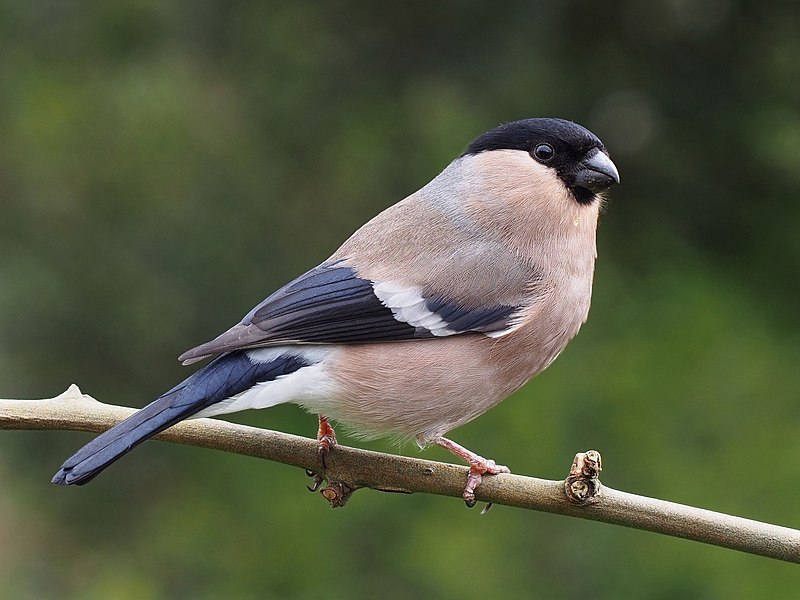
Finches are a diverse group of passerine birds found around the world, excluding Australia and polar regions. They vary in size from small to medium-sized, with stout conical bills adapted for eating seeds and nuts.
Many species have brightly coloured plumage; this helps them stand out against their natural habitats which can range from deserts to forests.
Finches occupy these areas all year round without migrating elsewhere – making them particularly well suited for local environments.
As part of the Fringillidae family they possess unique characteristics that make them popular amongst birdwatchers everywhere.Scientific classification:
| Kingdom | Animalia |
| Phylum | Chordata |
| Class | Aves |
| Order | Passeriformes |
| Superfamily | Passeroidea |
| Family | Fringillidae Leach, 1820 |
5. American Goldfinch
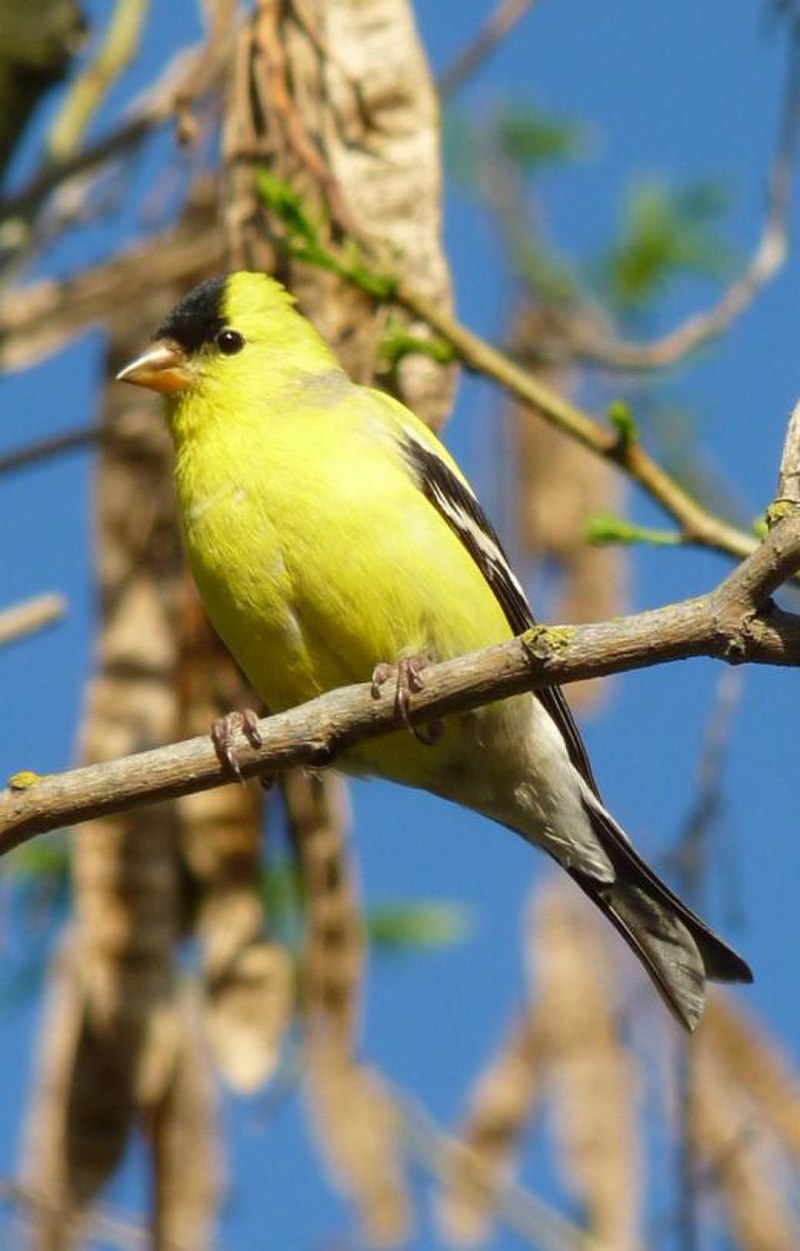
The American goldfinch is a small North American bird in the finch family. Males are vibrant yellow with black wings and tail, while females are duller in colouration.
It migrates from mid-Alberta to North Carolina during breeding season, south of Canada–United States border to Mexico for its wintering grounds.
The only finch which undergoes complete molt every year, it displays sexual dichromatism where males have brighter colours than their female counterparts.
They feed mainly on seeds but also eat insects such as aphids and caterpillars when raising youngs; they often occur near thistles or other plants that produce viable seed heads.
Their call consists of an array of chirps and trills making them quite conspicuous.Scientific classification:
| Kingdom | Animalia |
| Phylum | Chordata |
| Class | Aves |
| Order | Passeriformes |
| Family | Fringillidae |
| Subfamily | Carduelinae |
| Genus | Spinus |
| Species | S. tristis |
6. Blue Jay

The Blue Jay is a beautiful bird that resides in eastern and central United States, as well as Newfoundland Canada.
They have an unmistakable blue colored plumage with white markings on their heads and wings.
These birds are highly adaptable to different habitats ranging from deciduous forests to urban areas.
As part of the Corvidae family, they are known for being intelligent problem solvers who will often use tools or mimic vocalizations of other species like hawks when defending their territories.
Their diet consists mostly of insects, seeds and nuts but can also include small vertebrates such as frogs or lizards if food resources become scarce.
Overall these birds provide much needed color to our environment while playing important roles in maintaining healthy ecosystems through pollination services and seed dispersal activities.Scientific classification:
| Kingdom | Animalia |
| Phylum | Chordata |
| Class | Aves |
| Order | Passeriformes |
| Family | Corvidae |
| Genus | Cyanocitta |
| Species | C. cristata |
7. Red-Bellied Woodpecker
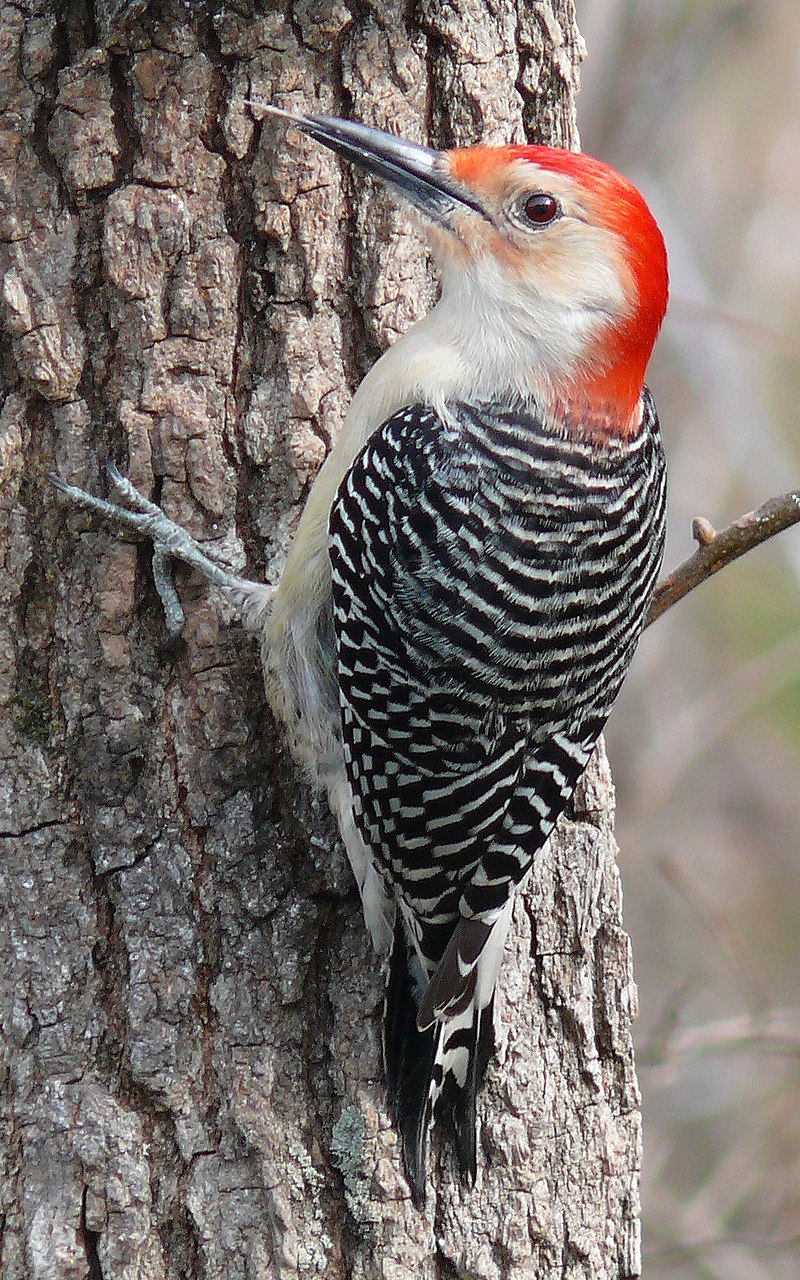
The Red-bellied woodpecker is a beautiful bird with an orange-red crown and nape. It breeds mainly in the eastern United States, ranging from Florida to Canada.
This medium-sized woodpecker of the family Picidae has black wings, white stripes on its back and tail feathers that are barred with black.
Its underside is mostly pale yellow or white but it also features some red coloration around its neck area.
Despite this subtle red hue, it should not be mistaken for the entirely red head and neck belonging to the Red-headed woodpecker of the same genus Melanerpes carolinus.
The Red bellied Woodpeckers diet consists primarily of insects such as ants, beetles and grasshoppers along with nuts fruits berries and tree sap which they will feed upon during different times throughout their life cycle.Scientific classification:
| Kingdom | Animalia |
| Phylum | Chordata |
| Class | Aves |
| Order | Piciformes |
| Family | Picidae |
| Genus | Melanerpes |
| Species | M. carolinus |
8. Downy Woodpecker
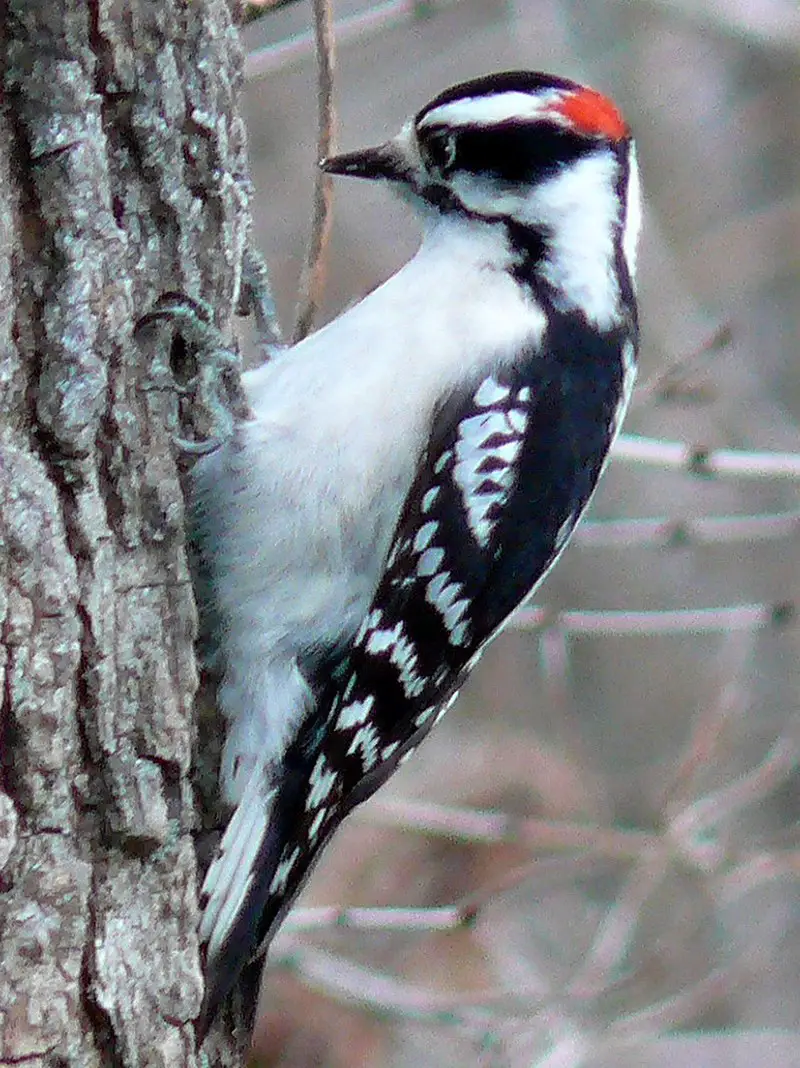
The downy woodpecker is a small species of woodpecker found in North America. Growing up to 7 inches long, it can be identified by its white belly and spotted wings.
It inhabits forests throughout the United States and Canada, with the exception of deserts in the southwest and northern tundra.
This bird nests in tree cavities and feeds mostly on insects but will supplement its diet with fruit or nuts when available.
The Downy Woodpecker has an unmistakable call that sounds like a loud ‘pik-er’, similar to other members of its family such as the Hairy Woodpecker.Scientific classification:
| Kingdom | Animalia |
| Phylum | Chordata |
| Class | Aves |
| Order | Piciformes |
| Family | Picidae |
| Genus | Dryobates |
| Species | D. pubescens |
9. Common Starling

The Common Starling is a medium-sized passerine bird that belongs to the starling family. It has glossy black plumage with a metallic sheen, and in certain times of year it can be speckled with white.
The bill and legs are typically pink or black depending on the season, while its length measures about 8 inches long.
Its diet consists mainly of insects but also includes small fruits and seeds as well as some human food waste.
They live in large flocks which provides protection against predators, although they can become quite aggressive when defending their nesting sites during breeding seasons.
Overall, this species is highly adaptable and widely distributed across many parts of Europe making them one of the most successful birds in the region today.Scientific classification:
| Kingdom | Animalia |
| Phylum | Chordata |
| Class | Aves |
| Order | Passeriformes |
| Family | Sturnidae |
| Genus | Sturnus |
| Species | S. vulgaris |
10. Mourning Dove
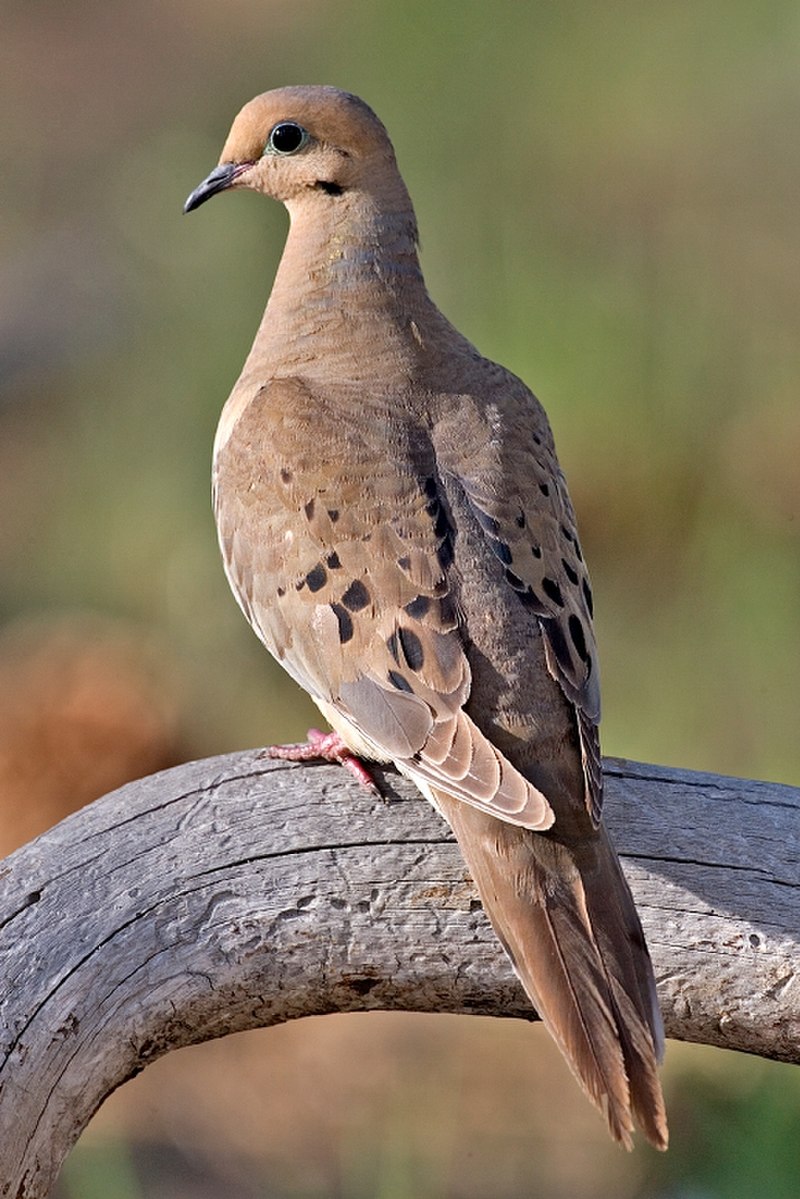
The Mourning Dove is a breathtakingly beautiful bird. It has stunning gray and brown feathers with white tipped wings, giving it an elegant appearance. Its long tail also adds to its graceful look in flight.
A symbol of peace and serenity, they are abundant across North America and can be found in gardens or open fields throughout the year.
As well as being popular game birds for hunters, they feed on grains such as wheat and millet providing important food sources for wildlife species including foxes, coyotes, skunks and raccoons.
These doves have a distinctive cooing sound that can often be heard echoing through woodlands during summer evenings making them one of nature’s greatest treasures.Scientific classification:
| Kingdom | Animalia |
| Phylum | Chordata |
| Class | Aves |
| Order | Columbiformes |
| Family | Columbidae |
| Genus | Zenaida |
| Species | Z. macroura |
11. Carolina Chickadee
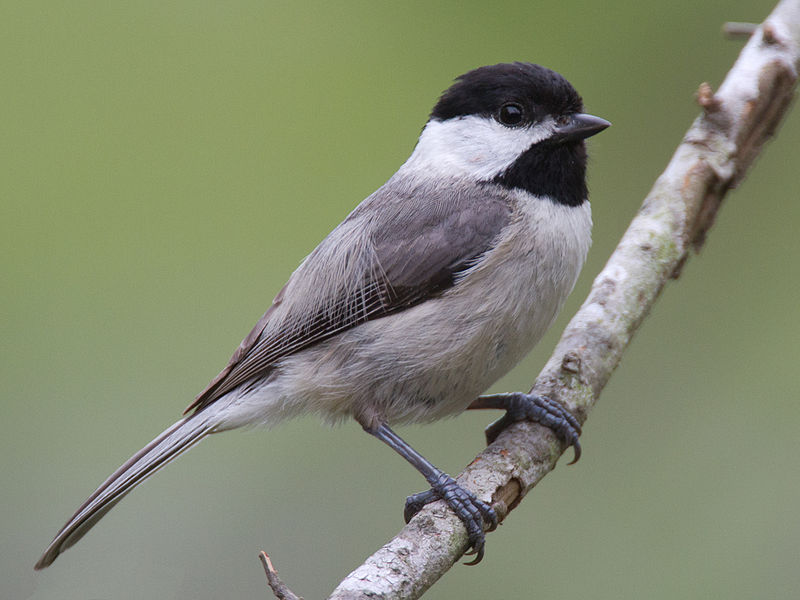
The Carolina Chickadee is a small passerine bird found in the tit family Paridae. It stands out for its distinct black and white, grey-brown feathers with an offwhite underside.
This species can be spotted by its call: “chick-a-dee”. The American Ornithologists’ Union has classified them into their own genus called Poecile as they differ from other tits due to both genetic data and morphology.
These birds are found all over North America, living in wooded areas near open fields or water sources.
They feed on insects such as caterpillars but also have been known to eat suet at backyard feeders during winter months when food is scarce.Scientific classification:
| Kingdom | Animalia |
| Phylum | Chordata |
| Class | Aves |
| Order | Passeriformes |
| Family | Paridae |
| Genus | Poecile |
| Species | P. carolinensis |
12. Tufted Titmouse

The Tufted Titmouse is a small, cheerful songbird found in North America. It’s part of the tit and chickadee family (Paridae).
It has distinctive white feathers around its eyes, grey-brown wings and upper body, with a pale tan underside.
Its most notable feature is the black crest on top of its head that gives it an inquisitive look. The male also sports a pinkish breast which can be seen.
When singing from high perches during the spring months. This bird loves to eat sunflower seeds or suet at backyard feeders as well as insects in summertime.
You may even see them poking into crevices and bark looking for food.
They are quite social birds too, being often spotted in mixed flocks alongside other species such as nuthatches and woodpeckers all year round.Scientific classification:
| Kingdom | Animalia |
| Phylum | Chordata |
| Class | Aves |
| Order | Passeriformes |
| Family | Paridae |
| Genus | Baeolophus |
| Species | B. bicolor |
13. Brown-Headed Cowbird
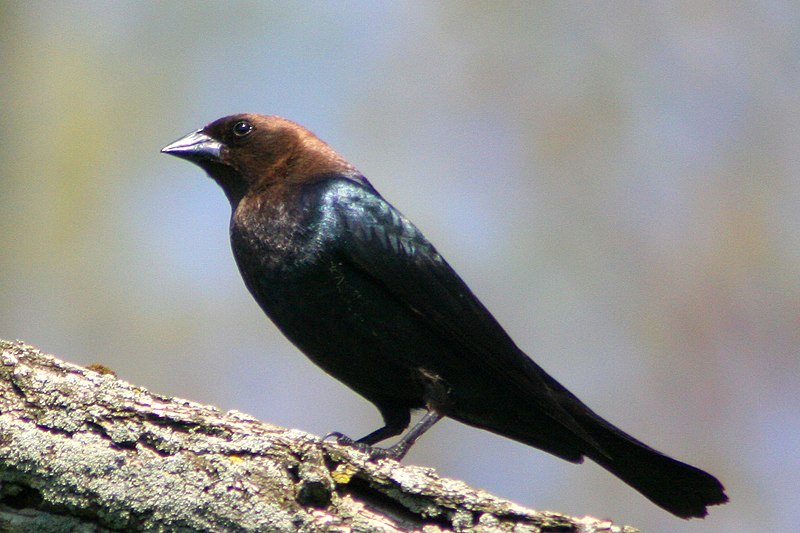
The Brown-headed Cowbird is a small, obligate brood parasitic icterid native to temperate and subtropical North America. It has a brown head with glossy black plumage on the body, wings and tail feathers.
During summer months it can be found in prairies, grasslands as well as open wooded areas but during winter they migrate southwards towards the United States of Mexico for warmer climate.
They are mainly insectivorous birds which feed on insects like caterpillars or beetles but also consume some grains too.
The female bird lays its eggs in nests of other species who then incubates them until hatching time thus leaving their own chicks uncared for by themselves.Scientific classification:
| Kingdom | Animalia |
| Phylum | Chordata |
| Class | Aves |
| Order | Passeriformes |
| Family | Icteridae |
| Genus | Molothrus |
| Species | M. ater |
14. House Finch

The House Finch is a species of finch native to western North America and has been introduced in the eastern half of the continent as well as Hawaii.
It’s an average-sized finch with adults measuring 12.5 – 15 cm (5 – 6 inches) long and having wingspans between 20 – 25 cm (8 – 10 inches).
The upperparts are brown, while its underparts range from pale grayish white to yellow depending on subspecies.
Its face is streaked or spotted with reddish coloration; males typically have brighter plumage than females due to sexual dimorphism.
They’re mostly found near human habitations such as farms and gardens where they feed on grains, fruits, insects etc., making them very popular among birders who want something colorful for their backyard.Scientific classification:
| Kingdom | Animalia |
| Phylum | Chordata |
| Class | Aves |
| Order | Passeriformes |
| Family | Fringillidae |
| Subfamily | Carduelinae |
| Genus | Haemorhous |
| Species | H. mexicanus |
15. Eastern Bluebird
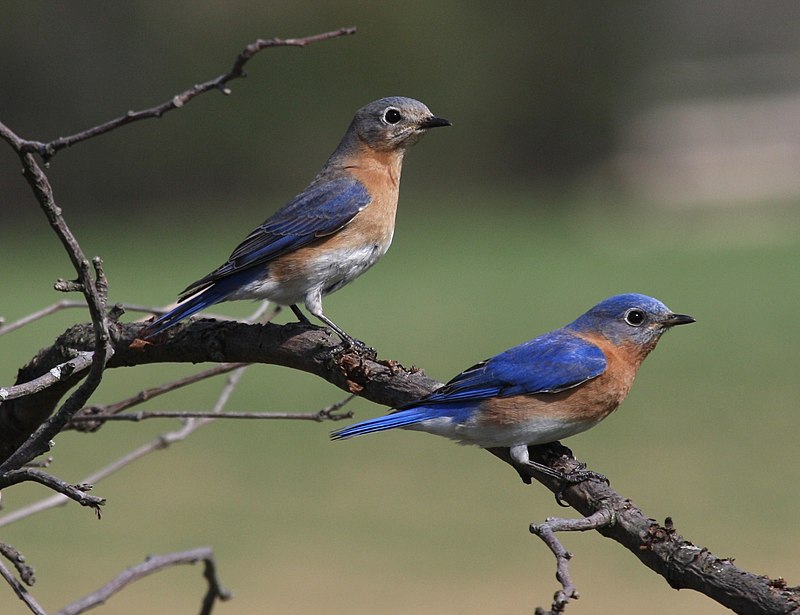
The Eastern bluebird is a small migratory thrush that can be found in open woodlands, farms and orchards across North America.
The male has bright-blue breeding plumage which makes it easily recognizable by birders.
It produces melodious songs such as jeew, chir-wi and chiti WEEW wewidoo.
This popular species was declared the state bird of Missouri back in 1927 due to its beauty and charm.
In addition to being beautiful, these birds are also beneficial for farmers because they eat insects like grasshoppers and beetles which damage crops.
They nest in cavities so providing nesting boxes helps them thrive even more.
With their vibrant colors, sweet melodies and helpful nature it’s easy to see why the Eastern Bluebird is beloved worldwide.Scientific classification:
| Kingdom | Animalia |
| Phylum | Chordata |
| Class | Aves |
| Order | Passeriformes |
| Family | Turdidae |
| Genus | Sialia |
| Species | S. sialis |
16. Carolina Wren
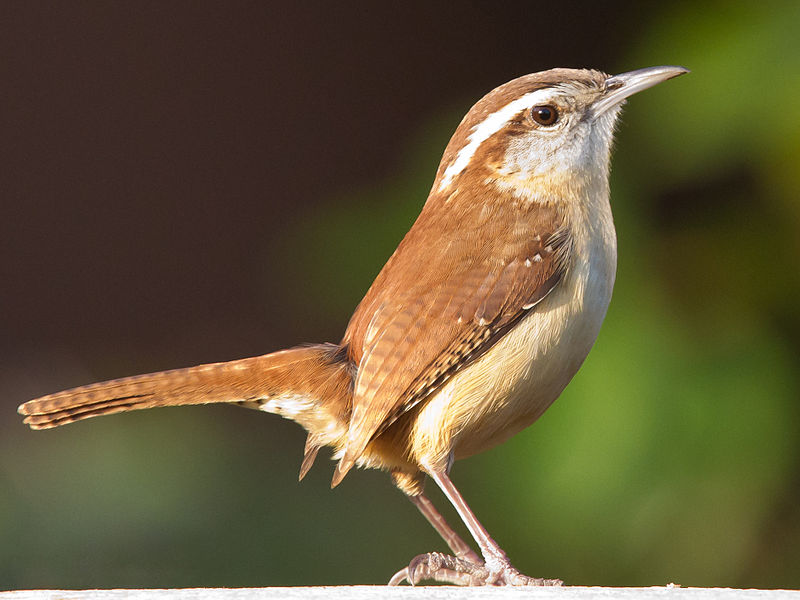
The Carolina wren (Thryothorus ludovicianus) is a medium-sized bird that can be found in the eastern United States, southern Ontario and northeast Mexico.
They typically live in dense shrubbery or thickets near open areas such as gardens, parks and woodland edges.
These birds are quite adaptable when it comes to nesting sites – they will build their nests anywhere from tree cavities to manmade boxes.
Their diet consists of insects, spiders and other invertebrates which they forage for on the ground or among vegetation.
The males have an unmistakable song made up of loud whistles interspersed with trills reminiscent of laughter; you’ll often find these cheerful little birds singing away during early morning hours.Scientific classification:
| Kingdom | Animalia |
| Phylum | Chordata |
| Class | Aves |
| Order | Passeriformes |
| Family | Troglodytidae |
| Genus | Thryothorus Vieillot, 1816[2] |
| Species | T. ludovicianus |
17. Northern Mockingbird
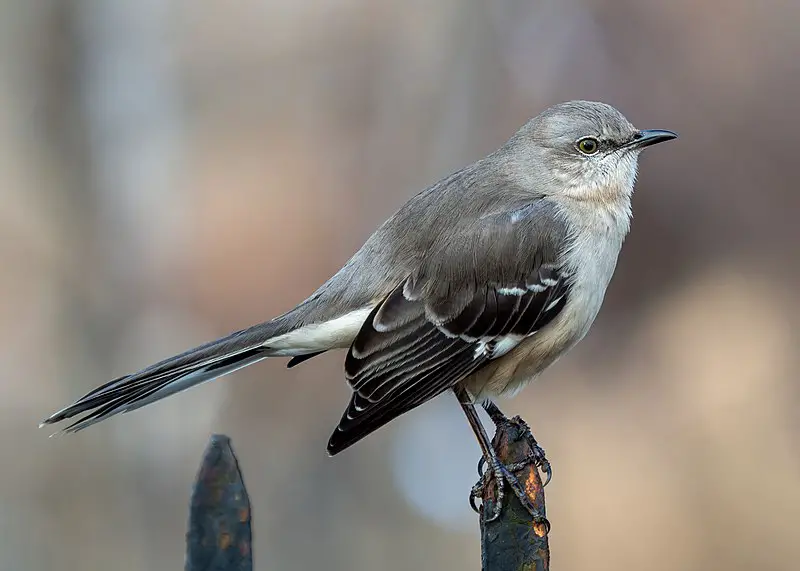
The northern mockingbird is a common fixture in North American skies. It has greyish-brown upperparts and a paler underside with white wing patches, and its distinctive long tail makes it easy to spot.
This adaptable bird can often be seen singing from the tops of trees or fences, though it rarely strays into Europe.
The species was first described by Carl Linnaeus in his 1758 Systema Naturae as Turdus polyglottos – aptly named for their remarkable ability to mimic other birds’ songs.
Northern mockingbirds typically live on insects, fruits, berries and seeds but they will also happily scavenge food scraps left out by humans.
With its beautiful song and striking plumage this beloved avian makes an important contribution to our environment.Scientific classification:
| Kingdom | Animalia |
| Phylum | Chordata |
| Class | Aves |
| Order | Passeriformes |
| Family | Mimidae |
| Genus | Mimus |
| Species | M. polyglottos |
18. Common Grackle

The Common Grackle is a large icterid bird commonly found in North America. It has an iridescent head and pale yellow eyes, which are framed by its long dark bill and long tail.
Males typically have more vivid colors on their heads than females do. These birds can be seen across much of the continent, in fields, forests, wetlands – even urban areas.
They form huge flocks to search for food such as grains or insects that they catch with their bills.
The grackles may also scavenge from human sources like garbage dumps or picnic tables if available. With its colorful plumage and distinct call it’s easy to spot this species amongst other birds.Scientific classification:
| Kingdom | Animalia |
| Phylum | Chordata |
| Class | Aves |
| Order | Passeriformes |
| Family | Icteridae |
| Genus | Quiscalus |
| Species | Q. quiscula |
19. American Crow

The American crow is a large bird of the Corvidae family, native to most parts of North America.
It is similar in size and structure to its European counterpart, the carrion crow, as well as Eurasia’s hooded crow.
The three species occupy the same ecological niche, but are distinguishable by their differences in appearance.
American crows have black feathers covering their entire body with wingspan averaging between 17-21 inches wide for males and 16-19 inches for females.
They feed on insects such as grasshoppers, beetles and caterpillars; they also eat grains from fields or abandoned farms during winter months when food sources become scarcer.
In addition to feeding habits American crows can be identified by their distinct call which resembles a “caw” sound that travels long distances over open terrain making them popular among birdwatchers.Scientific classification:
| Kingdom | Animalia |
| Phylum | Chordata |
| Class | Aves |
| Order | Passeriformes |
| Family | Corvidae |
| Genus | Corvus |
| Species | C. brachyrhynchos |
20. Red-Winged Blackbird

The red-winged blackbird is a beautiful bird found in most of North America and Central America.
Its distinct features include a glossy black body, with white shoulder patches and bright red wing coverts year round.
It prefers wetland habitats such as marshes, ponds, lakeshores and agricultural fields. During breeding season they inhabit grassy areas near water then move south for the winter months.
For food they mainly eat insects but also consume wild fruit or grains.
They are very social birds often seen in large flocks during migration times when their unmistakable “conk-la-ree” call can be heard echoing across the sky.Scientific classification:
| Kingdom | Animalia |
| Phylum | Chordata |
| Class | Aves |
| Order | Passeriformes |
| Family | Icteridae |
| Genus | Agelaius |
| Species | A. phoeniceus |
21. Cedar Waxwing
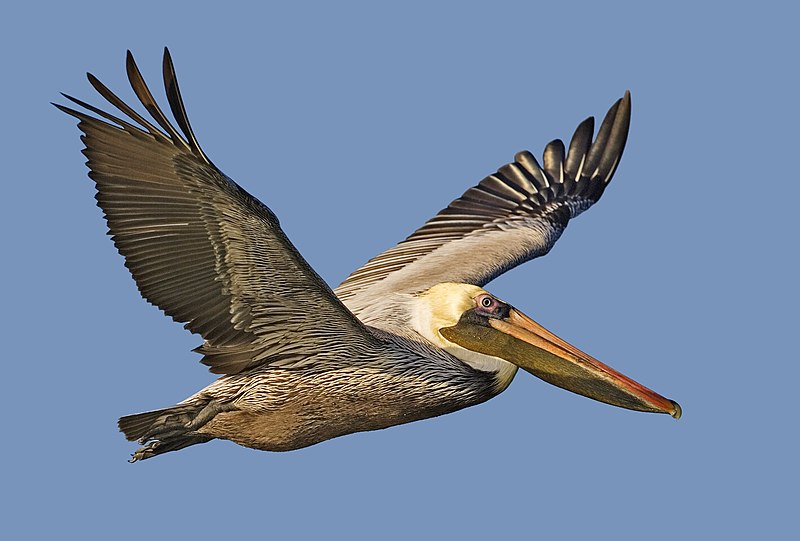
The Cedar Waxwing is a medium-sized bird that can be found in North America. They are identified by their soft brown plumage and bright yellow belly, along with the red tips on their wings and tail feathers.
These birds have long pointed wings, short legs, and a crest of black or dark gray feathers on top of its head.
The males can also be distinguished from the females by having brighter colors than the females do.
Cedar Waxwings feed mainly on berries but will occasionally eat insects as well for protein.
During breeding season they form flocks to hunt together then return back to individual nesting sites where they build cup-shaped nests lined with grasses and other materials near tree branches or shrubs close to water sources like rivers or lakes.
In addition to this diet of mostly fruit they sometimes consume small frogs, lizards, flowers buds and even lichens.
This species is listed as “Least Concern” due to its large population size across North America despite being hunted heavily during winter months when food resources become scarce
22. White-Throated Sparrow

The White-throated Sparrow is a small passerine bird of the New World sparrow family Passerellidae.
It has distinctive yellow and black stripes on its head, white throat and chest with grey back and wings, along with light brown legs.
The scientific name “Zonotrichia albicollis” comes from Ancient Greek for ‘band’ (ζώνη) referring to its distinctive striped crown, and Latin for ‘white neck’ (albus collum).
These birds are usually found in wooded areas such as coniferous forests or deciduous habitats in North America where they feed mainly on insects during summer months; transitioning to seeds during winter.
They build their nests near ground level using grasses, twigs or moss lined with feathers.
White-throated Sparrows may be solitary but also form flocks when migrating southward each fall season which typically occurs over mid-late October through November depending on location within range.Scientific classification:
| Kingdom | Animalia |
| Phylum | Chordata |
| Class | Aves |
| Order | Passeriformes |
| Family | Passerellidae |
| Genus | Zonotrichia |
| Species | Z. albicollis |
23. Ruby-Throated Hummingbird

The ruby-throated hummingbird (Archilochus colubris) is a species of hummingbird that has an impressive migration pattern, spending the winter in Central America, Mexico and Florida before flying to Canada and other parts of Eastern North America for breeding season.
It’s by far the most common type seen east of the Mississippi River in North America.
Formally described by Swedish naturalist Carl Linnaeus in 1758, this tiny bird has bright metallic green upperparts with white underparts, a small black bill and a red throat patch which gives it its name; they measure around 3 inches long on average.
They feed primarily on nectar from flowers but also eat insects such as flies or mosquitoes for extra protein during their migrations or when raising young chicks.Scientific classification:
| Kingdom | Animalia |
| Phylum | Chordata |
| Class | Aves |
| Order | Apodiformes |
| Family | Trochilidae |
| Genus | Archilochus |
| Species | A. colubris |
24. Pine Warbler
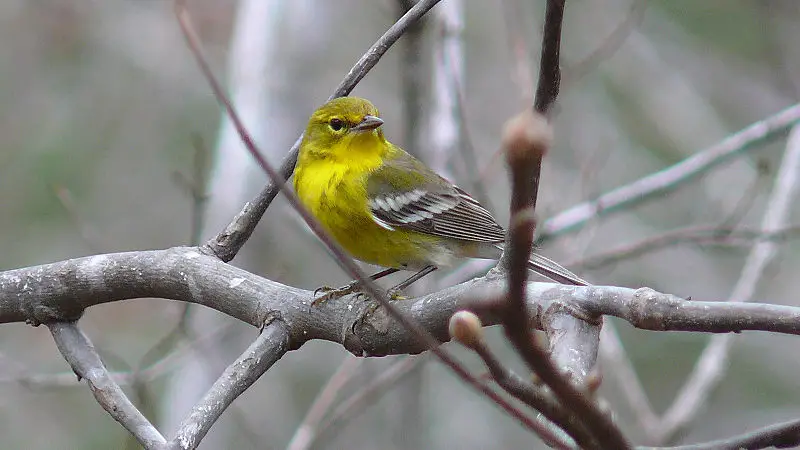
The Pine Warbler is a small bird from the New World warbler family, with an olive-brown upperparts and white belly.
Its distinguishing features include two white wing bars, dark legs, thin pointed bills and yellowish ‘spectacles’ around its eyes.
Adult males have bright yellow throats and breasts on top of their olive upperparts; females and immatures are less vibrant in colour but retain similar characteristics.
These birds can be found near pine forests throughout North America during summer months before migrating to warmer climates for winter.
They feed mainly on insects such as caterpillars, spiders and flies while also consuming fruits like blueberries when food becomes scarce in colder times of year.
All in all, these tiny songbirds provide us with much beauty through their unique plumage patterns whilst serving important roles within their ecosystems.Scientific classification:
| Kingdom | Animalia |
| Phylum | Chordata |
| Class | Aves |
| Order | Passeriformes |
| Family | Parulidae |
| Genus | Setophaga |
| Species | S. pinus |
25. Orchard Oriole
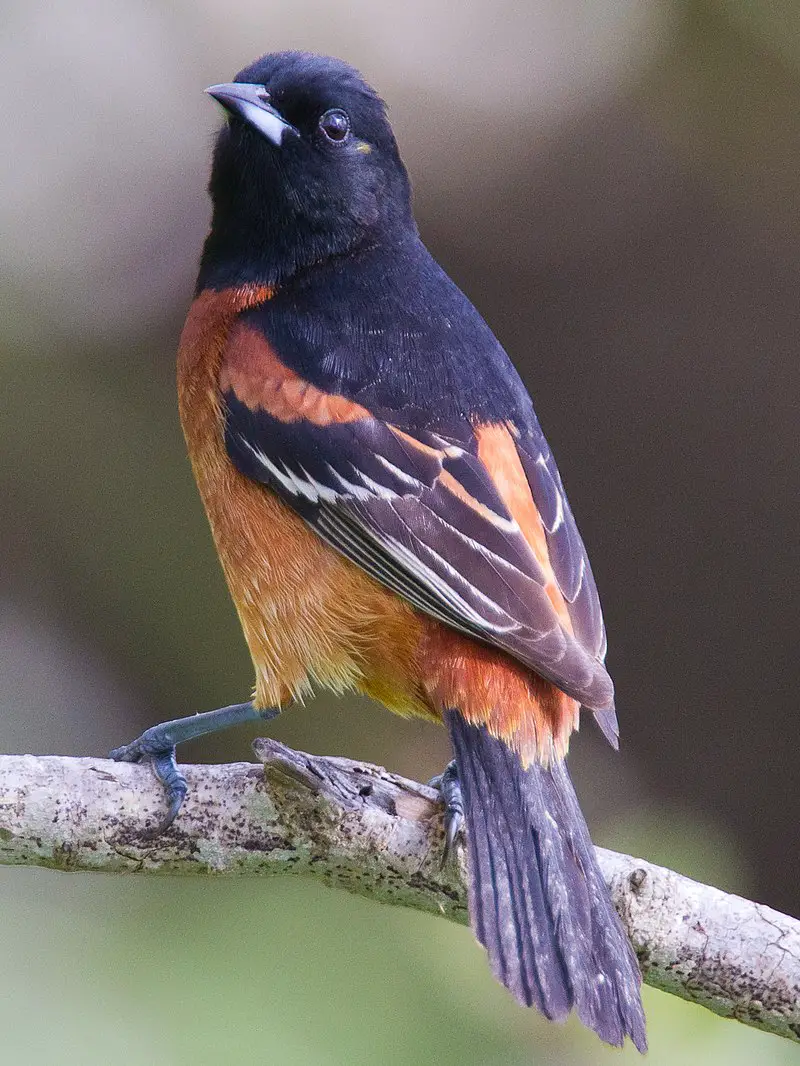
The Orchard Oriole is a small species of icterid bird, with the subspecies I. s. fuertesi sometimes considered its own separate species known as the Ochre or Fuertes’ Oriole.
The adult male of the nominate subspecies has chestnut upperparts and black wings and tail, while females are more yellowish-green in coloration on their back and wings.
Its bill is pointed, black in color with some blue-gray at the base of its lower mandible.
This beautiful bird can also be found across North America during migration season; they inhabit woodlands near streams or rivers to breed before migrating south for winter months.Scientific classification:
| Kingdom | Animalia |
| Phylum | Chordata |
| Class | Aves |
| Order | Passeriformes |
| Family | Icteridae |
| Genus | Icterus |
| Species | I. spurius |
26. Orange-Crowned Warbler
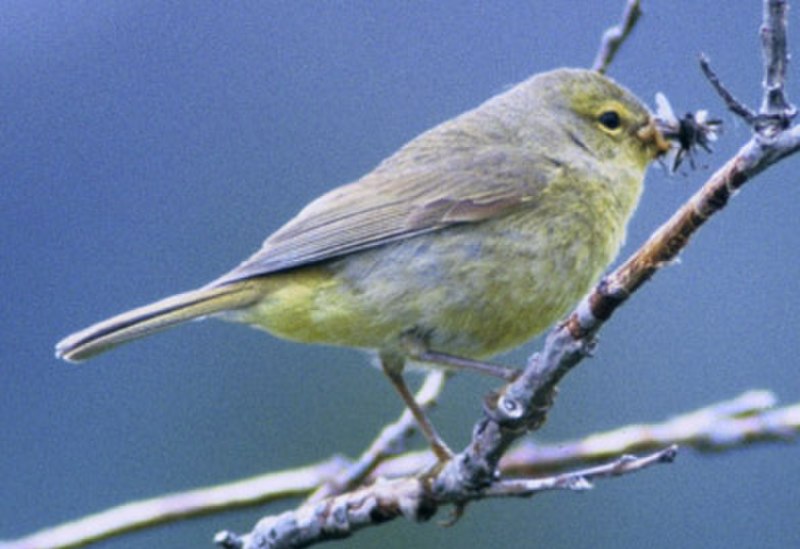
The Orange-crowned Warbler is a small songbird from the New World warbler family. It was formally described in 1822 by Thomas Say, who gave it its scientific name Sylvia celatus – Latin for ‘cloaked’.
This species has an olive green back and wings with yellowish underparts. The males have bright orange crowns during breeding season, which give this bird its namesake.
They can be found mainly in North America but they also migrate to Central America during winter months.
Their diet consists of insects such as butterflies, moths, grasshoppers and beetles; they may also consume fruits occasionally when available.
These birds are relatively quiet except for their mating calls which include whistles or buzzing sounds that last a few seconds long each time.
The Orange-crowned Warbler is one of the most wide spread passerines today due to their hardiness and adaptability; however there remains threat of habitat destruction that could affect many populations negatively if not addressed soon enough.Scientific classification:
| Kingdom | Animalia |
| Phylum | Chordata |
| Class | Aves |
| Order | Passeriformes |
| Family | Parulidae |
| Genus | Leiothlypis |
| Species | L. celata |
27. Painted Bunting
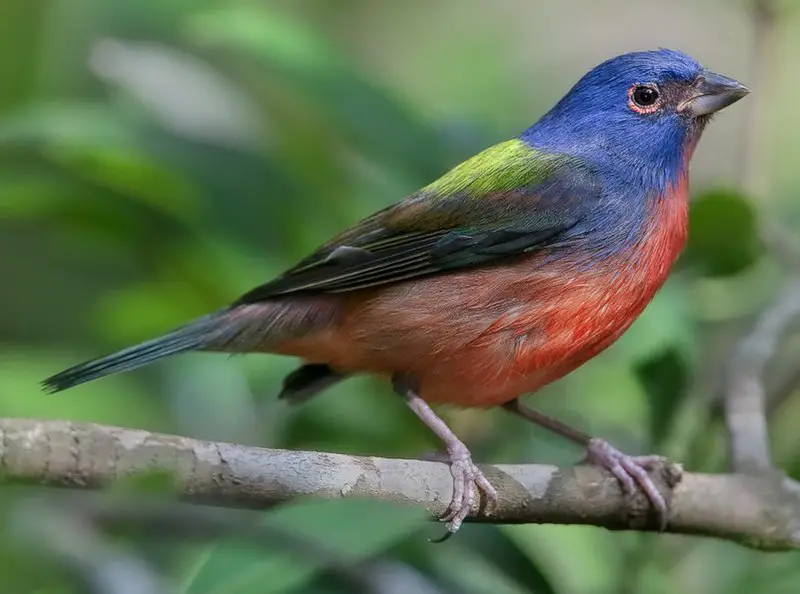
The Painted Bunting is an eye-catching bird from the Cardinal family, native to North America. It was first described by Carl Linnaeus in his eighteenth-century Systema Naturae.
The males of this species are particularly striking; they have brightly coloured plumage which only appears after their second year of life and can be distinguished from female birds through close inspection.
These colourful songbirds are a delight for any avid birder, with their vibrant hues bringing joy to nature lovers everywhere.
They often inhabit woodland areas where there is plenty of seed and insects available for them to feed on – as well as some shrubbery so that they can hide away safely when needed.Scientific classification:
| Kingdom | Animalia |
| Phylum | Chordata |
| Class | Aves |
| Order | Passeriformes |
| Family | Cardinalidae |
| Genus | Passerina |
| Species | P. ciris |
28. Common Yellowthroat

The Common Yellowthroat is a small, New World Warbler found throughout North America. It has distinctive yellow and black plumage that earned it the nickname “Yellow Bandit” in the Midwest United States.
This species is highly adaptable and can be found inhabiting wetlands, grasslands, shrub-land habitats, as well as suburban areas.
The genus of this bird’s scientific name translates to mean ‘ground’ and ‘small bird’, which are fitting characteristics for such an elusive yet common little creature.
Its diet consists predominantly of insects but may also include other invertebrates like spiders or worms.
Overall the Common Yellowthroat makes an excellent addition to any backyard with its cheerful song.Scientific classification:
| Kingdom | Animalia |
| Phylum | Chordata |
| Class | Aves |
| Order | Passeriformes |
| Family | Parulidae |
| Genus | Geothlypis |
| Species | G. trichas |
29. Chipping Sparrow
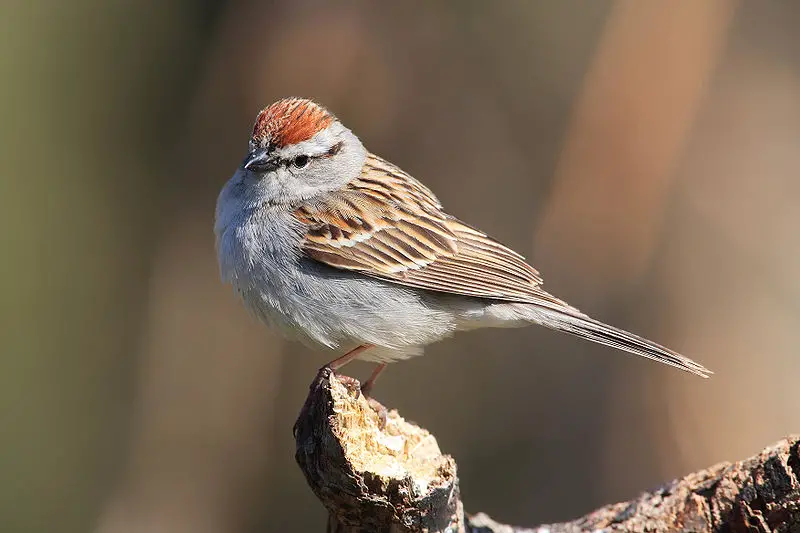
The Chipping Sparrow is a small passerine bird found across most of North America. It has two subspecies, the eastern and western chipping sparrows which migrate seasonally to overwinter in warmer climates.
The birds are grey above with white underparts, have a rufous cap with black stripes and large eyes surrounded by light brown feathers.
They feed mainly on seeds but can also be seen eating insects during breeding season when raising their young chicks.
These intrepid little birds live in open grasslands such as prairies or meadows where they build cup-shaped nests in trees or shrubs to raise their young family.
Their cheerful song often sounds like ‘chips’ hence its name; Chipping Sparrow.Scientific classification:
| Kingdom | Animalia |
| Phylum | Chordata |
| Class | Aves |
| Order | Passeriformes |
| Family | Passerellidae |
| Genus | Spizella |
| Species | S. passerina |
30. Anhinga

The Cedar Waxwing is a medium-sized bird that can be found in North America. They are identified by their soft brown plumage and bright yellow belly, along with the red tips on their wings and tail feathers.
These birds have long pointed wings, short legs, and a crest of black or dark gray feathers on top of its head.
The males can also be distinguished from the females by having brighter colors than the females do.
Cedar Waxwings feed mainly on berries but will occasionally eat insects as well for protein.
During breeding season they form flocks to hunt together then return back to individual nesting sites where they build cup-shaped nests lined with grasses and other materials near tree branches or shrubs close to water sources like rivers or lakes.
In addition to this diet of mostly fruit they sometimes consume small frogs, lizards, flowers buds and even lichens.
This species is listed as “Least Concern” due to its large population size across North America despite being hunted heavily during winter months when food resources become scarce
31. Baltimore Oriole
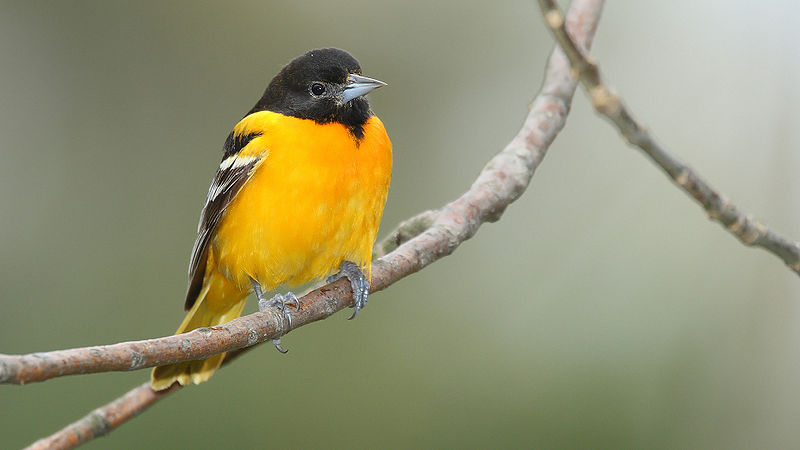
The Baltimore Oriole is a small, blackbird-like bird found in eastern North America. It’s named for the resemblance of its male colors to those on Lord Baltimore’s coat-of-arms from 17th century.
These birds migrate and breed during springtime and are quite common in their habitats.
Studies have shown that this species interbreeds with western Bullock’s orioles, leading both to be classified as a single species – Icterus galbula.
The males typically have orange feathers along the chest, back, wings and tail while females display tan or yellowish shades instead of bright orange ones like males do.
Both sexes share white wing bars and dark brown eyes which makes them easily distinguishable among other birds.
They can often be seen flitting around trees feeding off nectar buds or insects such as grasshoppers & caterpillars they catch while flying around.Scientific classification:
| Kingdom | Animalia |
| Phylum | Chordata |
| Class | Aves |
| Order | Passeriformes |
| Family | Icteridae |
| Genus | Icterus |
| Species | I. galbula |
32. Cerulean Warbler
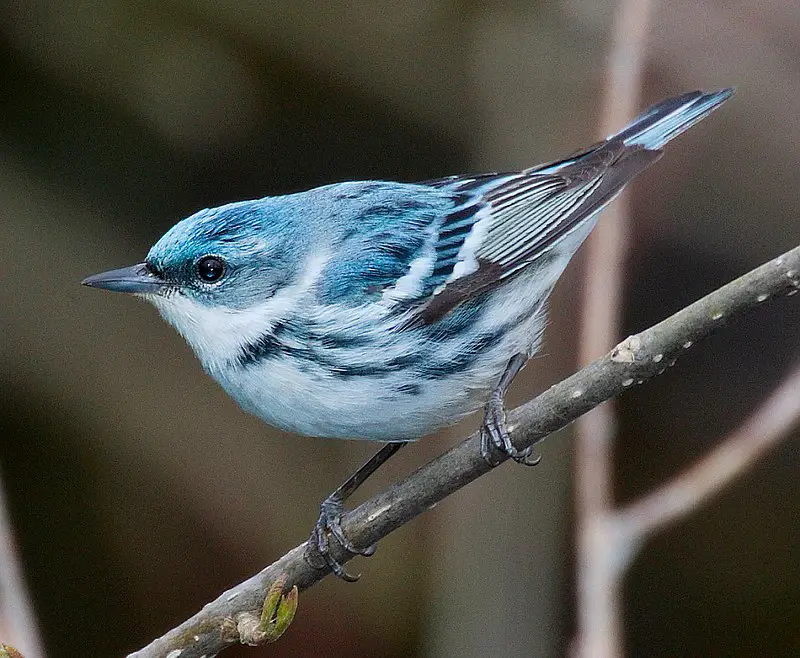
The Cerulean Warbler is a small songbird in the Parulidae family. It migrates long distances, breeding in eastern North American hardwood forests and spending its non-breeding season on the east slope of the Andes in South America.
This bird displays strong sexual dichromatism with adult males having vivid cerulean blue and white upperparts with black streaks running down their neck to chest area.
Females have an olive green color above with yellowish tones beneath them, along with some dark streaks as well.
These birds feed mainly on insects but also consume fruits during migration or when rearing young ones.
They make nests near tree trunks and lay three to five eggs per clutch which hatch after about 10 days of incubation by both parents.
The Cerulean Warbler is classified as Near Threatened due to human disturbances such as habitat loss caused by deforestation amongst other factors like climate change that threaten this species’ survival.Scientific classification:
| Kingdom | Animalia |
| Phylum | Chordata |
| Class | Aves |
| Order | Passeriformes |
| Family | Parulidae |
| Genus | Setophaga |
| Species | S. cerulea |
Also Featured In: Blue Birds You’ll Found around Us, Birds Commonly Found in New York
33. Purple Martin
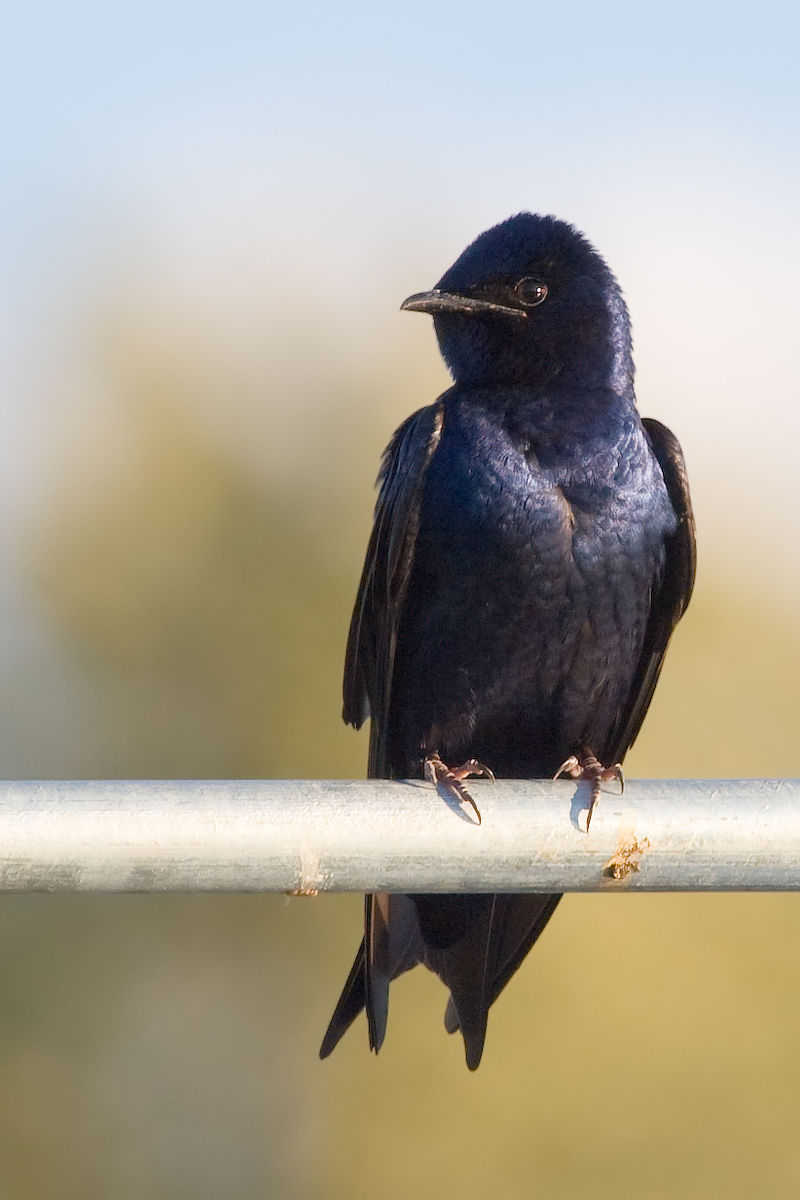
The Purple Martin is a beautiful passerine bird in the swallow family, and is the largest of its kind in North America.
It has dark blackish-blue feathers that have an iridescent sheen which can make them appear blue or deep purple depending on the light; they may even look green.
These birds are quite social creatures and often build communal roosts with multiple nests, having as many as hundreds of individuals living together at once.
They feed mainly on flying insects such as flies, moths, wasps and bees.
Their habitats include areas near bodies of water like lakes or rivers where there’s plenty for these birds to eat all year round.
The Purple Martin is truly an amazing species worth protecting.Scientific classification:
| Kingdom | Animalia |
| Phylum | Chordata |
| Class | Aves |
| Order | Passeriformes |
| Family | Hirundinidae |
| Genus | Progne |
| Species | P. subis |
34. White-Breasted Nuthatch

The White-breasted Nuthatch is a medium-sized bird belonging to the nuthatch family Sittidae. It measures around 15.5 cm in length and its colour varies throughout its range.
Males have a light blue-grey upperpart, with black crown and nape whereas females have a dark grey crown instead of black one.
The underparts are whitish, with reddish tinge on sides and flanks while the bill is short and stout with pale base near eyes which can be yellow or white depending upon geographic location..
This species feeds mainly on insects but will also eat seeds, nuts and berries when available.
They prefer open woodlands where they often climb trees searching for food along trunks as well as branches underneath bark crevices creating their nest there too.Scientific classification:
| Kingdom | Animalia |
| Phylum | Chordata |
| Class | Aves |
| Order | Passeriformes |
| Family | Sittidae |
| Genus | Sitta |
| Species | S. carolinensis |
35. Blue-Gray Gnatcatcher
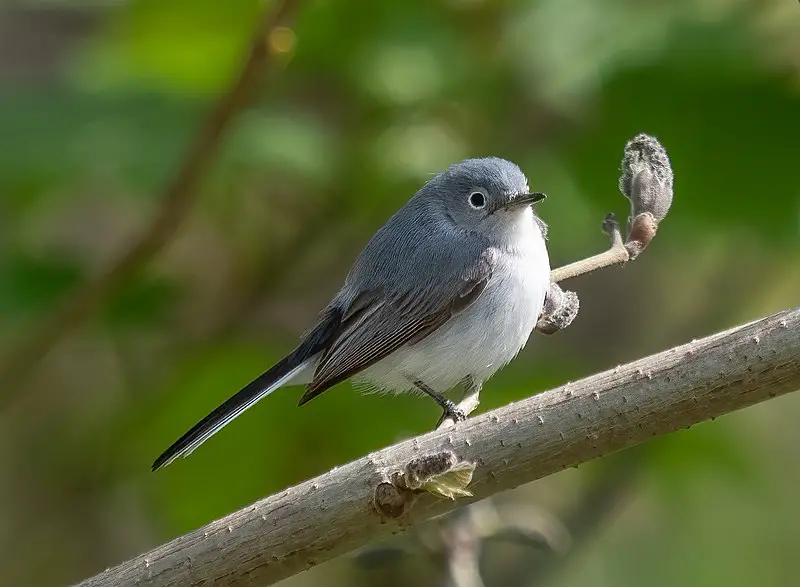
The Blue-gray Gnatcatcher is a beautiful small songbird native to North America. It has a length of 10–13 cm (3.9–5.1 in), wingspan of 6.3 in (16 cm) and weighs only 5–7 g (0.18–0.25 oz).
Males have blue-gray upperparts with white underparts, slender dark bill, and long black tail edged in white; females are less vibrant but still eye catching.
Juveniles are brownish gray overall but may show some hints of the adult colouration around their tails or shoulders as they mature into adulthood.
Their diet consists mainly of insects which they catch while flitting through air like tiny darts.
This stunning species can be found anywhere from woodlands to urban parks so keep your eyes peeled for these delightful creatures on your next outdoor adventure.Scientific classification:
| Kingdom | Animalia |
| Phylum | Chordata |
| Class | Aves |
| Order | Passeriformes |
| Family | Polioptilidae |
| Genus | Polioptila |
| Species | P. caerulea |
36. American White Ibis
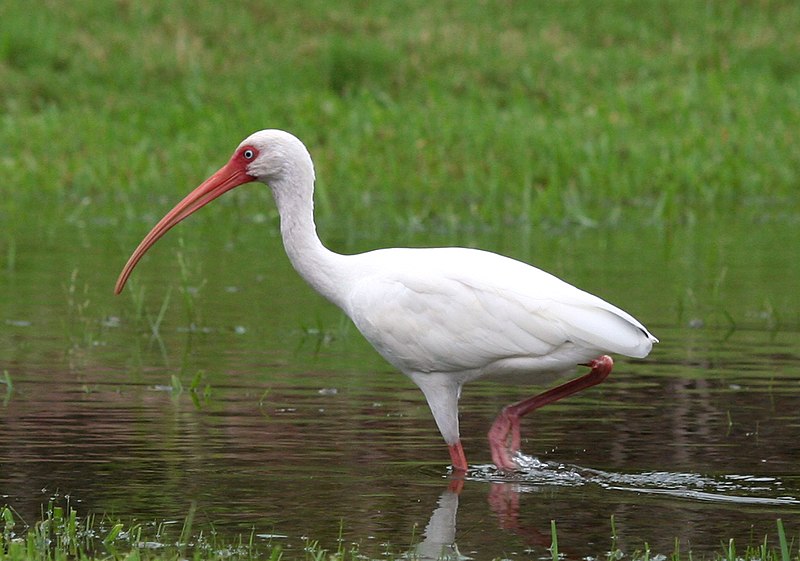
The American white ibis is a medium-sized bird with an overall white plumage and long legs. It has a bright red-orange downward curved bill, and black wing tips that are usually only visible in flight.
This species of ibis can be found from Virginia south through most of the coastal New World tropics.
They have been known to inhabit marshes, swamps, ponds, lakeshores as well as mangrove forests near water sources where they feed on crustaceans such as crabs and shrimp among other aquatic animals like insects or snails.
The American white ibis plays an important role in its ecosystem by helping to control insect populations which helps maintain balance within these environments.Scientific classification:
| Kingdom | Animalia |
| Phylum | Chordata |
| Class | Aves |
| Order | Pelecaniformes |
| Family | Threskiornithidae |
| Genus | Eudocimus |
| Species | E. albus |
37. Yellow-Breasted Chat

The Yellow-breasted Chat is a large songbird found in North America, and is the only member of its family Icteriidae.
It was once part of the New World Warbler family but has since been moved to its own group due to taxonomic uncertainty.
This bird stands out as it was previously thought to be the largest species within Parulida.
Its plumage features shades of yellow, olive green and browns; males have darker heads while females are slightly paler overall.
The chat’s diet consists mostly of insects such as caterpillars and beetles which they forage from low vegetation or glean off leaves on tree branches during summer months when their populations peak.
They also feed heavily on fruits like elderberry, grapes and wild cherries during migration periods throughout spring/fall season providing much needed energy for long journeys southwards or northwards depending upon geography location each year.Scientific classification:
| Kingdom | Animalia |
| Phylum | Chordata |
| Class | Aves |
| Order | Passeriformes |
| Superfamily | Emberizoidea |
| Family | Icteriidae Baird, 1858 |
| Genus | Icteria Vieillot, 1808 |
| Species | I. virens |
38. Indigo Bunting
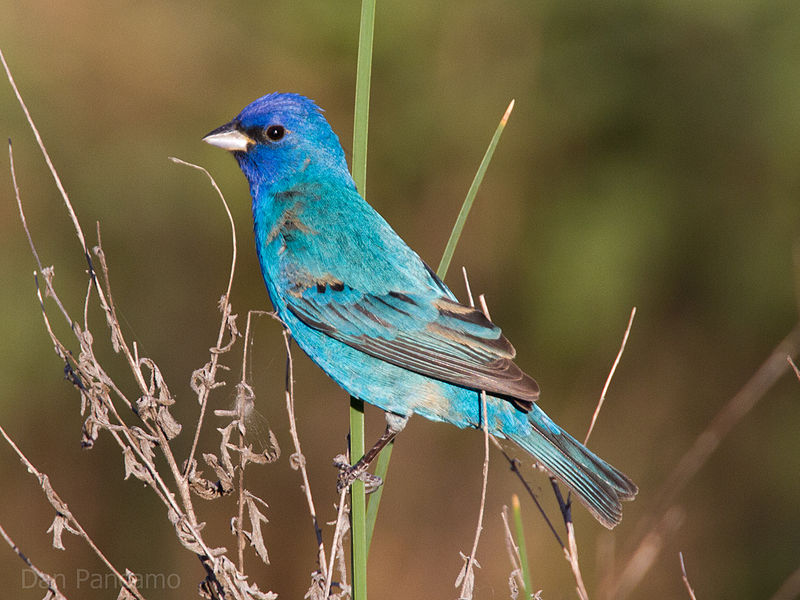
The Indigo Bunting is a small bird in the cardinal family, found throughout North and South America.
It has an unmistakable bright blue plumage that stands out against its natural habitat of farmland, brush areas and open woodland.
During breeding season it can be seen from southern Canada to northern Florida while during winter months it migrates south towards Central and Northern South America.
The Indigo Bunting prefers to migrate at night using the stars as navigation aids.
This species feeds on insects and seeds which they find near the ground or catch mid-flight with their agile wingspan.
An iconic sight for many farmers across both continents, these birds are a welcome addition to any backyard oasis or wildflower meadow.Scientific classification:
| Kingdom | Animalia |
| Phylum | Chordata |
| Class | Aves |
| Order | Passeriformes |
| Family | Cardinalidae |
| Genus | Passerina |
| Species | P. cyanea |
39. Pileated Woodpecker
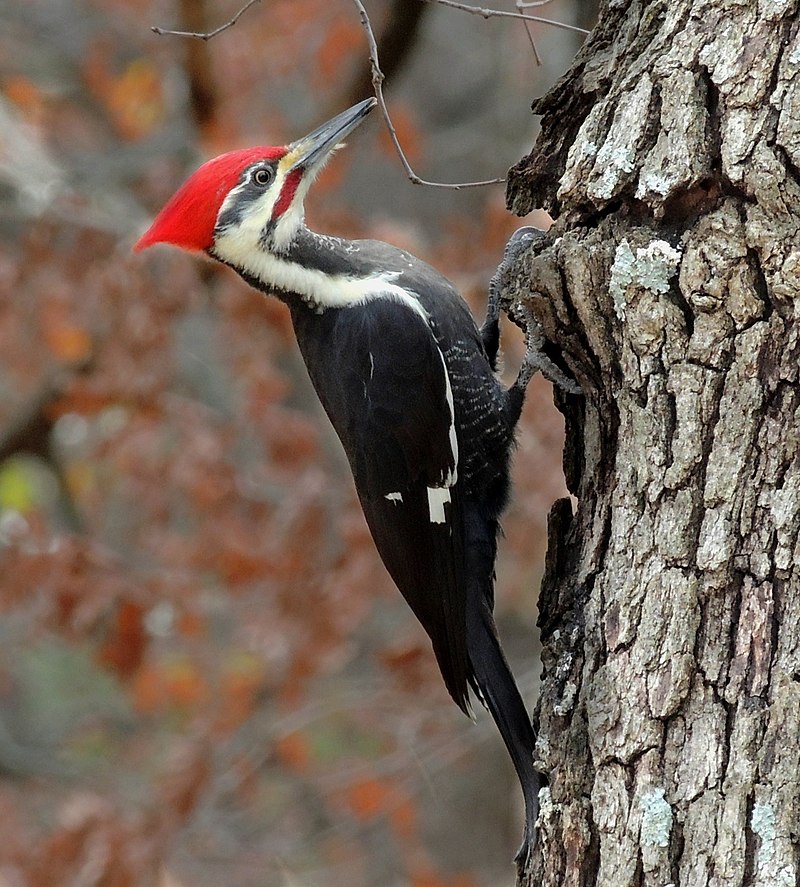
The pileated woodpecker is a large, majestic bird native to North America.
Its striking black plumage and red crest make it an unmistakeable sight in the forest canopy of deciduous forests across eastern North America, Great Lakes region, Canada’s boreal forests, and parts of the Pacific Coast.
It is one of the largest woodpeckers in North America: larger than any other confirmed species except for perhaps its relative; the ivory-billed woodpecker.
Insectivorous by nature, this stunning creature can be seen pecking away at tree trunks searching for food or making nest cavities – all with remarkable skill.
The pileated woodpecker truly stands out as a symbol of beauty and resilience amongst our avian wildlife.Scientific classification:
| Kingdom | Animalia |
| Phylum | Chordata |
| Class | Aves |
| Order | Piciformes |
| Family | Picidae |
| Genus | Dryocopus |
| Species | D. pileatus |
40. Red-Headed Woodpecker
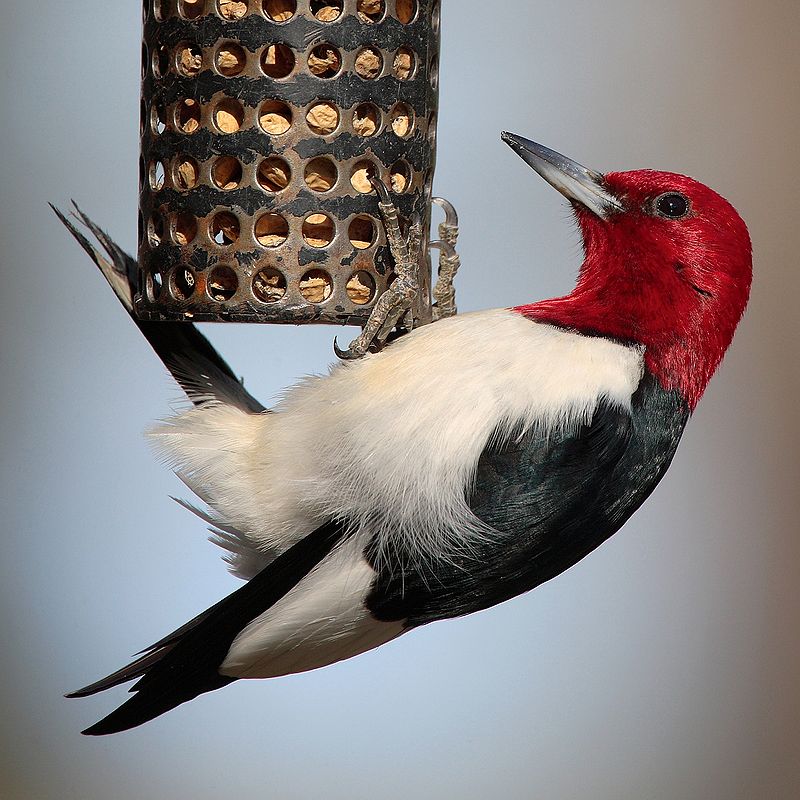
The red-headed woodpecker is a mid-sized bird found in temperate North America. It has striking plumage, with its head and neck being bright red while the rest of its body is primarily black and white.
Its wings are rounder than other similar species, allowing it to maneuver through tight spaces easily when searching for food or shelter.
The breeding habitat of this bird consists mainly of open fields across Canada and the east-central United States.
Despite facing threats such as deforestation, urbanization, predation from larger birds, collisions with windows or cars due to their inquisitive nature.
These birds remain listed on IUCN’s Red List as least concern thanks largely in part to conservation efforts by local governments and organizations dedicated to protecting wildlife habitats.Scientific classification:
| Kingdom | Animalia |
| Phylum | Chordata |
| Class | Aves |
| Order | Piciformes |
| Family | Picidae |
| Genus | Melanerpes |
| Species | M. erythrocephalus |
41. New World Orioles
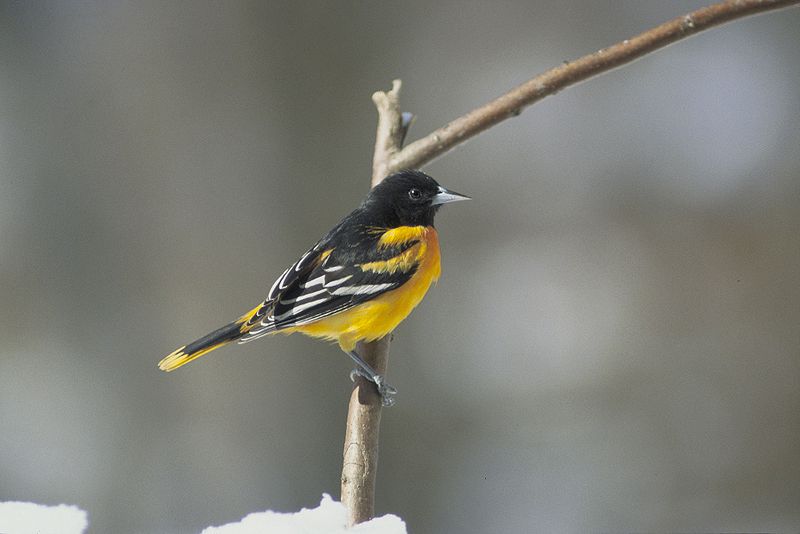
New World orioles are a group of birds belonging to the blackbird family. They share many features with Old World orioles, including size, diet and behaviour; however they differ in their striking plumage.
Males have bright yellow or orange bodies with contrasting black wings and white markings on the head and breast.
Females and immature birds tend to be duller colours such as browns and greys. These colourful songbirds feed primarily on fruit, insects, nectar from flowers or sap from trees – sometimes even raiding other nests for eggs.
Their cheerful chirps can often be heard throughout parks during summertime months.Scientific classification:
| Kingdom | Animalia |
| Phylum | Chordata |
| Class | Aves |
| Order | Passeriformes |
| Family | Icteridae |
| Genus | Icterus Brisson, 1760 |
Also Featured In: Summer Birds that Live around Us, Black And White Birds You Don’t Know About
42. Barred Owl
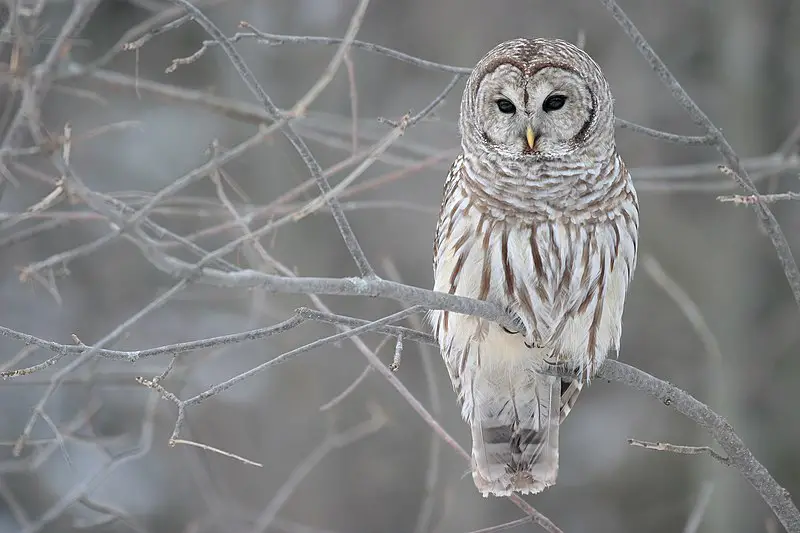
The Barred Owl is a large species of owl native to eastern North America. It belongs to the genus Strix, which is part of the true owl family Strigidae.
These beautiful birds are mainly brown with distinct stripes on their bodies and wings. Its face has dark eyes, a white chin patch and two black bars across its yellow-brownish beak, giving it an intimidating appearance.
The barred owls have powerful talons that they use for hunting small mammals like mice and voles as well as other animals such as fish, amphibians or insects.
They also rely heavily on hearing when looking for prey in low light conditions.
With their amazing camouflage abilities these birds can often remain undetected while observing potential threats from predators – making them highly successful hunters.Scientific classification:
| Kingdom | Animalia |
| Phylum | Chordata |
| Class | Aves |
| Order | Strigiformes |
| Family | Strigidae |
| Genus | Strix |
| Species | S. varia |
43. Louisiana Waterthrush
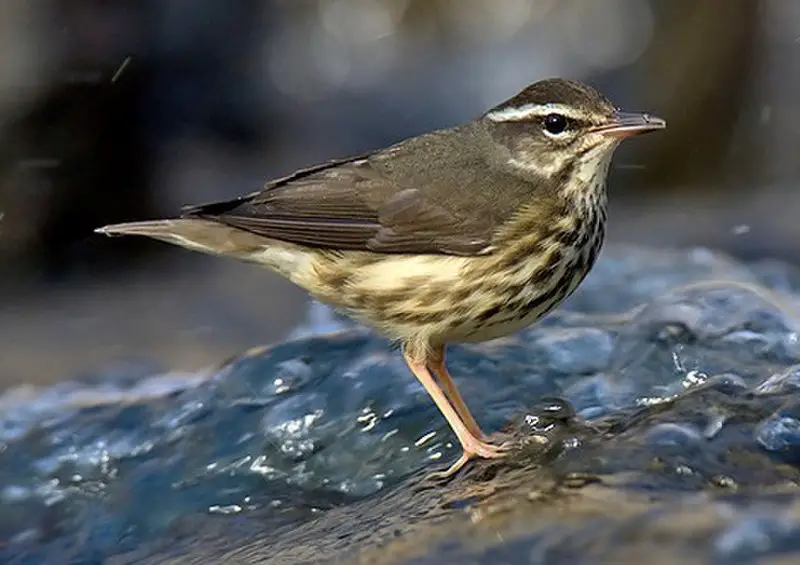
The Louisiana Waterthrush is a small songbird found in North America. It has a brown back, white belly and buff flanks with black streaks on its chest.
This bird prefers wet areas such as streams and their surroundings, where it can feed on aquatic insects or forage along the shoreline of ponds or lakes.
The Louisiana Waterthrush migrates to Central America during winter months but returns to breed in eastern North America during summertime.
Its call sounds like “drip-drop” which helps distinguish it from the Northern waterthrush that makes more of a buzzing sound when calling out for food or mates.Scientific classification:
| Kingdom | Animalia |
| Phylum | Chordata |
| Class | Aves |
| Order | Passeriformes |
| Family | Parulidae |
| Genus | Parkesia |
| Species | P. motacilla |
44. Song Sparrow

The Song Sparrow (Melospiza melodia) is a small, yet abundant bird found in North America.
They have brown upperparts with dark streaks and are white underneath, complete with a distinct dark brown spot on the breast.
Their cap is also brown and long roughed feathers can be seen sprouting from their neck area.
This sparrow species is highly variable and adaptable to many different environments including dry brush land, wetlands or open fields.
It has been noted that adult song sparrows will sing even during winter months when other birds remain quiet.
These energetic little animals make for great backyard companions as they flit about singing their lovely melodies.Scientific classification:
| Kingdom | Animalia |
| Phylum | Chordata |
| Class | Aves |
| Order | Passeriformes |
| Family | Passerellidae |
| Genus | Melospiza |
| Species | M. melodia |
45. House Wren
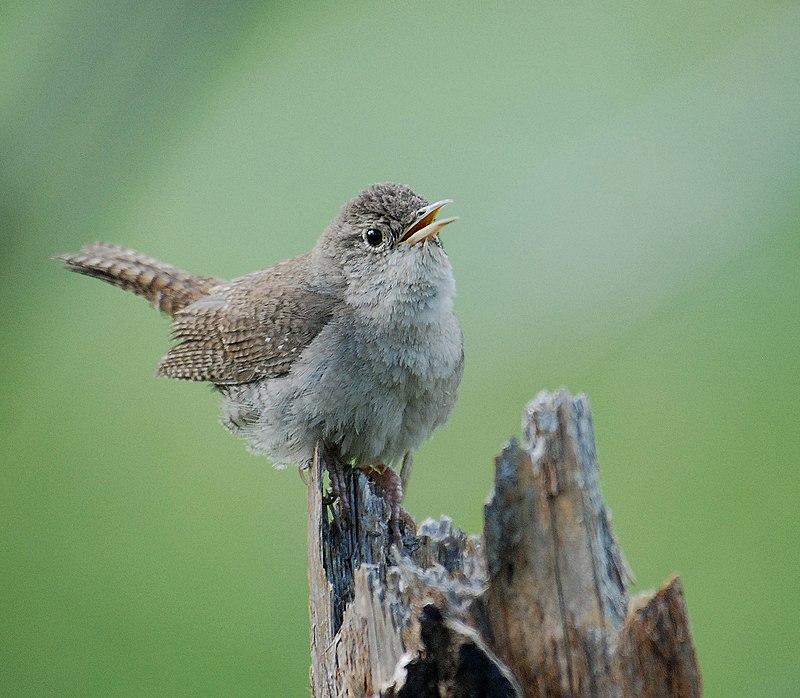
The House Wren is a small bird of the wren family found from Canada to South America. It’s quite common in suburban areas and is one of the most widely distributed native birds in North and South America.
Its taxonomy can be complicated, with some subspecies groups considered separate species.
The House Wren has a brown back, grey head, white eyebrow stripes, light chestnut belly and buffy flanks.
They often inhabit old or abandoned buildings as well as shrublands near fields or open woods for nesting sites.
During breeding season they are highly territorial so make sure you create an inviting environment if you wish to invite them into your yard.Scientific classification:
| Kingdom | Animalia |
| Phylum | Chordata |
| Class | Aves |
| Order | Passeriformes |
| Family | Troglodytidae |
| Genus | Troglodytes |
| Species | T. aedon |
46. Little Blue Heron
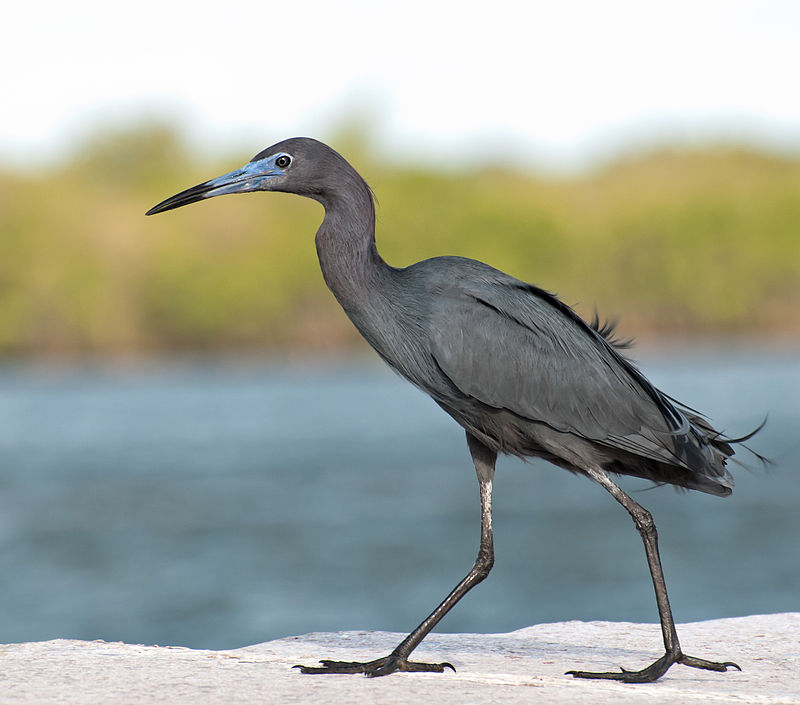
The Little Blue Heron is a small, darkly-colored heron with two-toned bill. Juveniles are completely white, similar to the Snowy Egret. In breeding season, adults develop unique coloration on their head and legs.
The bird has an expansive habitat range that covers much of the Americas from North America all the way down to South America.
They feed mostly in shallow water areas like tidal flats or marshes and eat small aquatic animals such as fish, frogs and crustaceans.
This species can also be found along coastal regions where they gather at night for roosting purposes during winter months when food sources become more scarce due to migration patterns of its prey animals.
These birds have adapted well over time allowing them to persist in most habitats throughout their wide range even despite environmental changes caused by human activities such as pollution or development projects near wetlands ecosystems which are essential for this species’ survival.Scientific classification:
| Kingdom | Animalia |
| Phylum | Chordata |
| Class | Aves |
| Order | Pelecaniformes |
| Family | Ardeidae |
| Genus | Egretta |
| Species | E. caerulea |
47. Northern Waterthrush
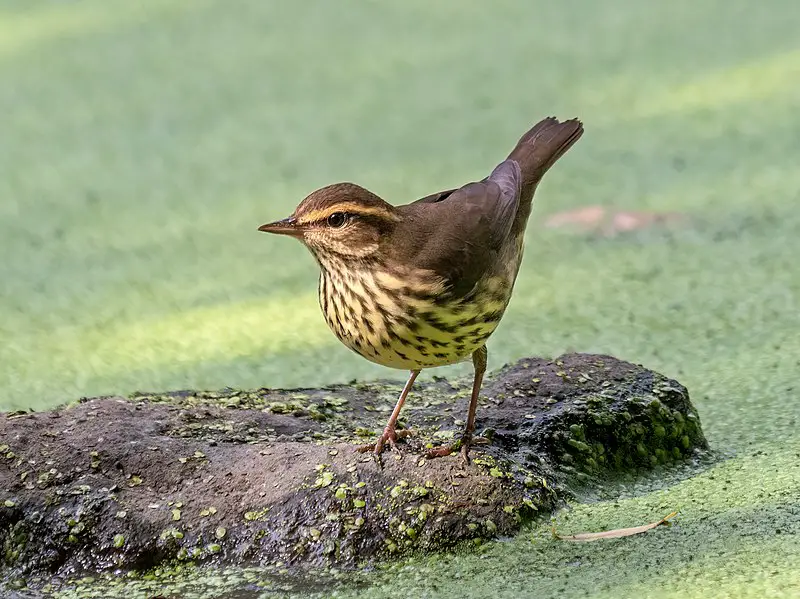
The northern waterthrush (Parkesia noveboracensis) is a small species of migratory New World warbler that breeds in Canada and the northern United States, including Alaska.
During winter it can be found across Central America, as well as parts of South America such as Venezuela, Colombia and Ecuador. It’s a rare vagrant to other regions within South America.
This ground-feeding bird has bright yellow or olive brown upperparts with white streaks down its back along with dark spots on its chestnut coloured throat and breast.
Its belly ranges from light greyish-white to creamy white depending on age; older birds tend towards the latter colouration while juveniles are lighter in tone.
This hardy little creature is able to brave both cold climates during breeding season and also tropical areas when migrating further south for winter months.Scientific classification:
| Kingdom | Animalia |
| Phylum | Chordata |
| Class | Aves |
| Order | Passeriformes |
| Family | Parulidae |
| Genus | Parkesia |
| Species | P. noveboracensis |
Also Featured In: British Virgin Islands Birds You Need to See, Adirondack Mountain Birds
48. Hermit Thrush
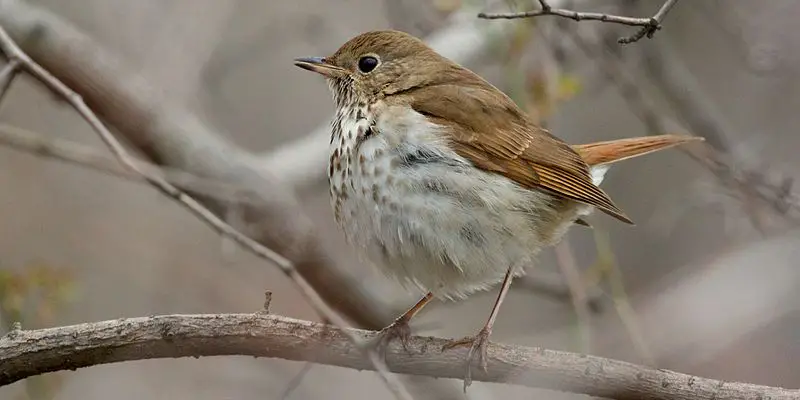
The Hermit Thrush is a medium-sized bird native to North America. It is easily identified by its spotted feathers and measures between 15-18 cm in length, with wingspan of 25-30 cm across.
This species has an unmistakable sweet song which can be heard during the spring and summer months throughout its range.
They feed on invertebrates such as insects, spiders, worms, snails and berries when available seasonally.
The habitat of this thrush includes deciduous woodlands or thickets near streams or wetlands where they are known to nest high up in trees making them difficult to observe directly but their beautiful songs can often be heard from afar.Scientific classification:
| Kingdom | Animalia |
| Phylum | Chordata |
| Class | Aves |
| Order | Passeriformes |
| Family | Turdidae |
| Genus | Catharus |
| Species | C. guttatus |